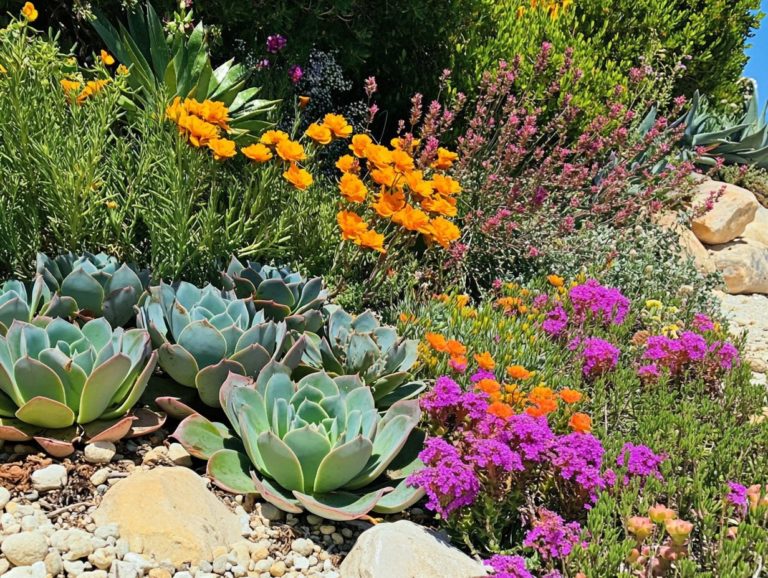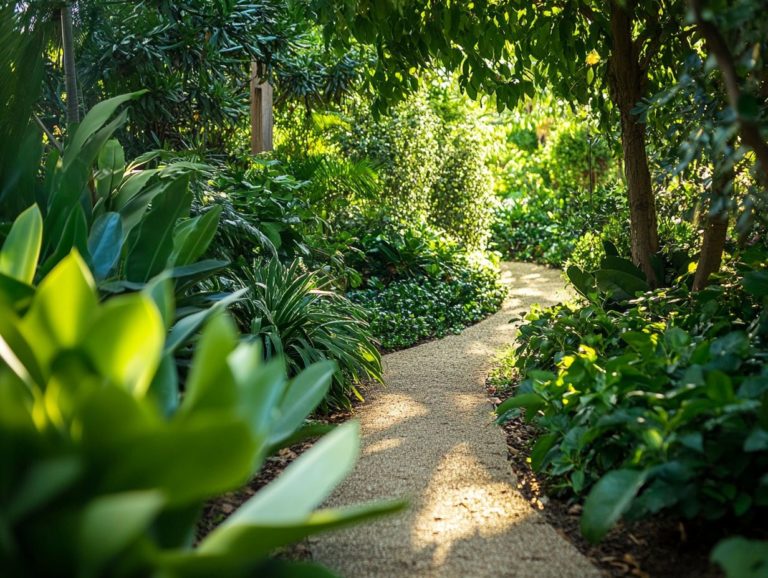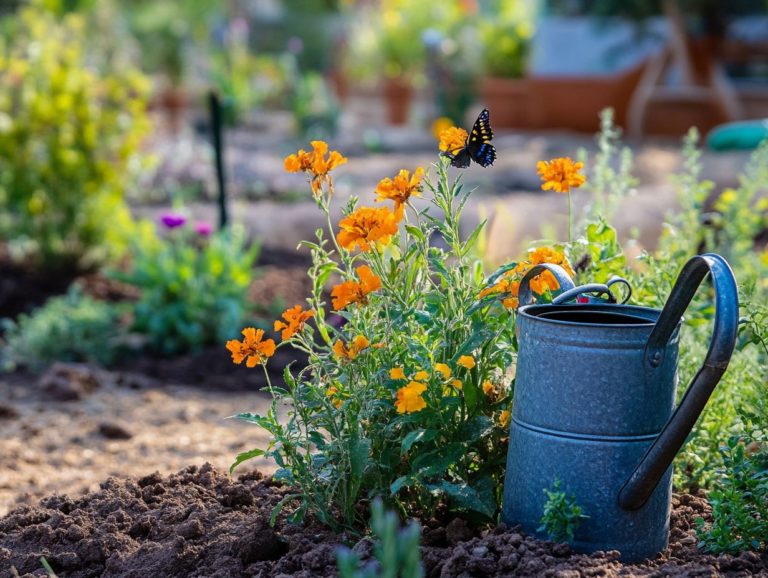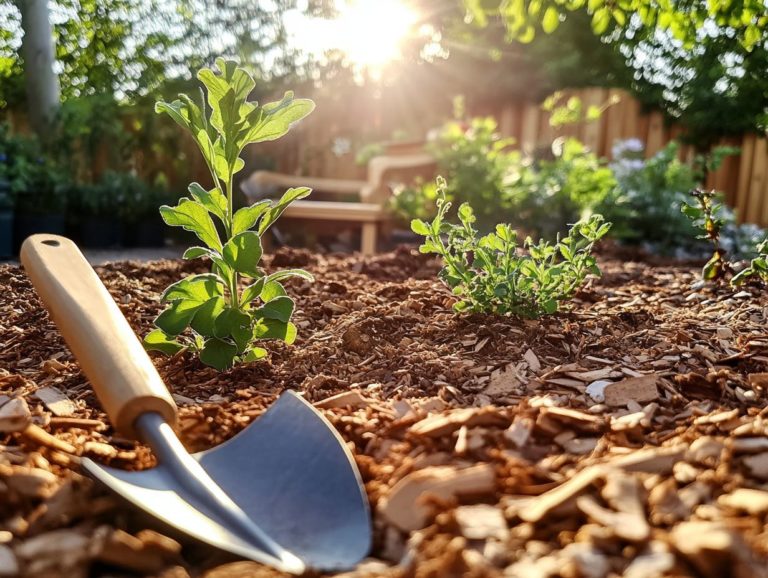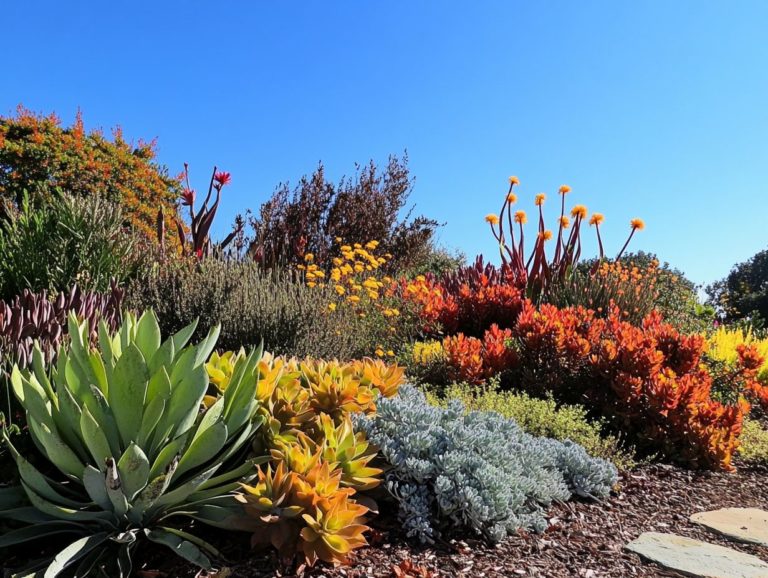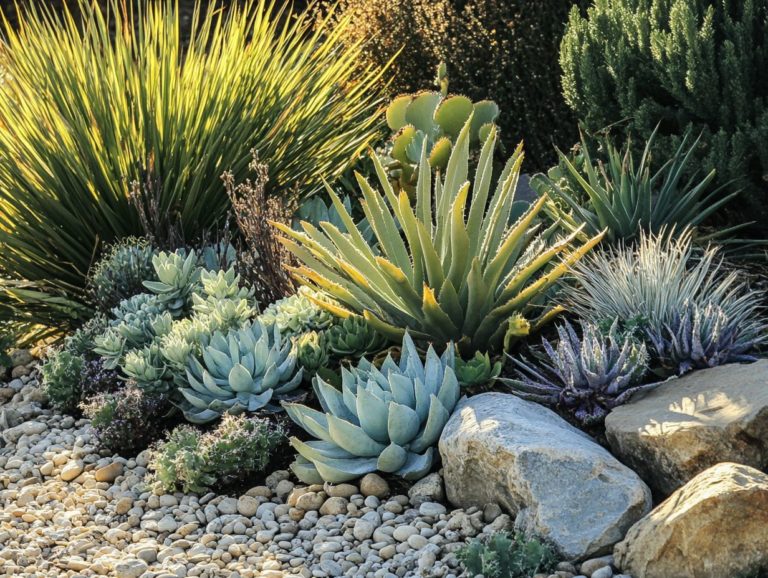What Are the Top Questions About Drought Gardening?
Drought gardening is gaining significance in today’s world, where water scarcity and unpredictable weather patterns pose challenges to traditional gardening practices.
Drought gardening focuses on essential practices. It offers both environmental and economic benefits. You’ll discover the vital tools and techniques for preparing your garden, learn about plants that need little water, and uncover effective watering strategies.
You will discover tips for keeping your drought garden healthy for years to come.
Dive into this exciting gardening journey and transform your space!
Contents
Key Takeaways:
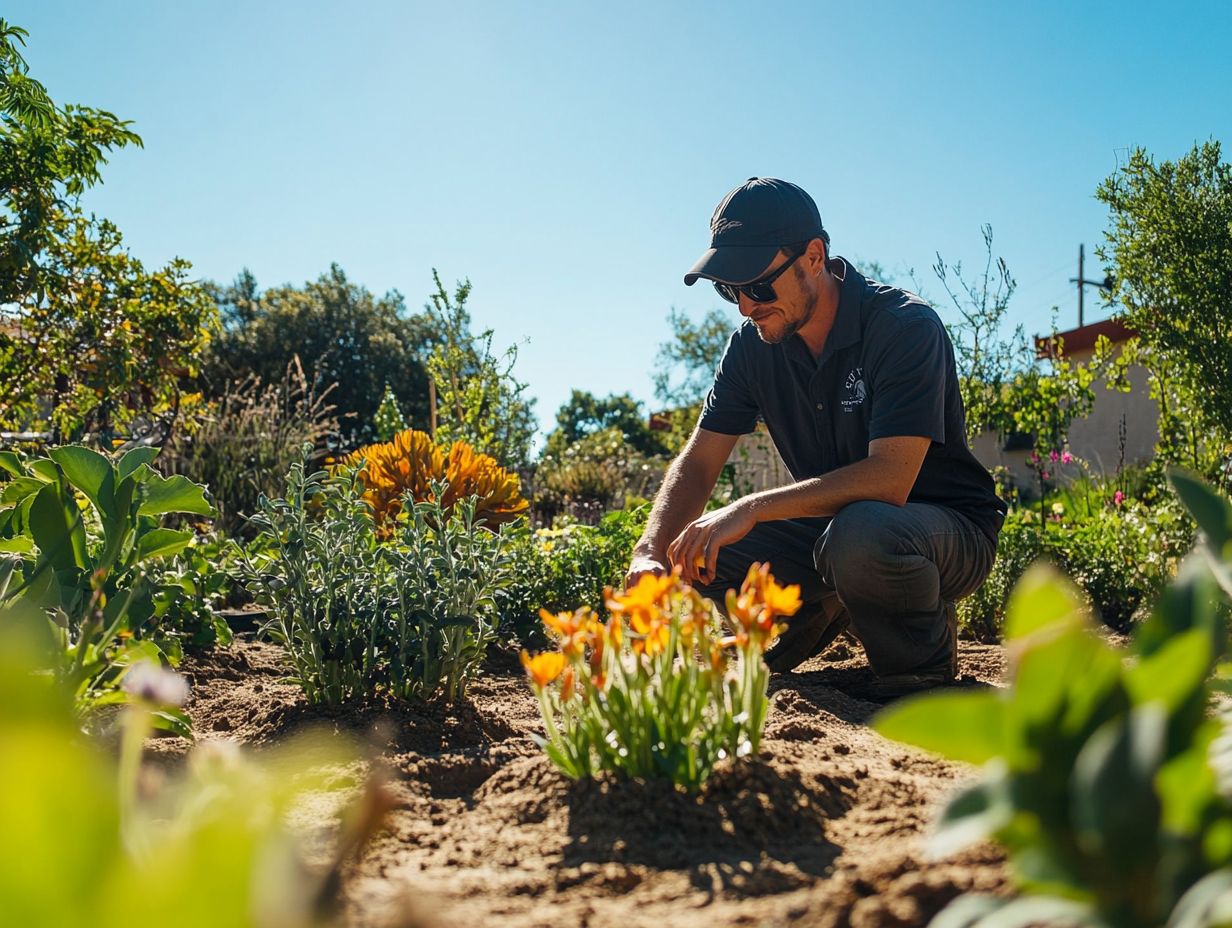
- Drought gardening is a method of gardening that involves growing plants that can withstand long periods of dry weather.
- Drought gardening not only helps conserve water but also saves money on utility bills and supports a diverse ecosystem.
- Proper preparation, plant selection, and efficient watering techniques are essential for successful drought gardening in the long run.
Understanding Drought Gardening
Understanding drought gardening is crucial for creating sustainable gardens that thrive with limited water. This practice involves knowing common mistakes to avoid in drought gardening, choosing the right plants, utilizing efficient irrigation methods, and prioritizing soil health.
Using compost and mulch helps keep your soil moist and promotes the growth of a diverse array of vegetation.
Furthermore, engaging with your community and spreading awareness can deepen your understanding of environmental conservation, positioning drought gardening as a vital practice in contemporary horticulture.
What is Drought Gardening?
Drought gardening is all about cultivating plants that are expertly adapted to thrive in low-water conditions, and there are various resources available to assist you. Exploring what resources can help beginner drought gardeners can provide valuable insights on techniques that optimize soil moisture and minimize water needs.
As water scarcity becomes a pressing global concern, this practice is gaining importance. By choosing drought-resistant plants think succulents, native grasses, and select perennials you can create an eco-friendly landscape that flourishes even in arid conditions.
Techniques like applying mulch serve the dual purpose of retaining soil moisture while enhancing water efficiency, and using drip irrigation systems, which deliver water directly to the roots of plants, can elevate your gardening game even further.
Incorporating organic matter into the soil will improve its moisture retention, ensuring your plants get the hydration they need during dry spells.
By implementing these practices, you not only conserve water but also promote biodiversity and contribute to a sustainable environment.
Benefits of Drought Gardening
The advantages of drought gardening reach far beyond the confines of your own garden; they play a crucial role in environmental sustainability, economic efficiency, and the well-being of communities. Understanding what is the best irrigation for drought gardens makes them essential in our climate-challenged world.
As local communities increasingly adapt to extended periods of drought, embracing sustainable practices not only conserves precious water resources but also enriches soil health and fosters biodiversity.
By prioritizing native plants and organic composting techniques, you can make a meaningful contribution to ecological conservation while reaping the rewards of your efforts through fresh, homegrown vegetables.
Benefits
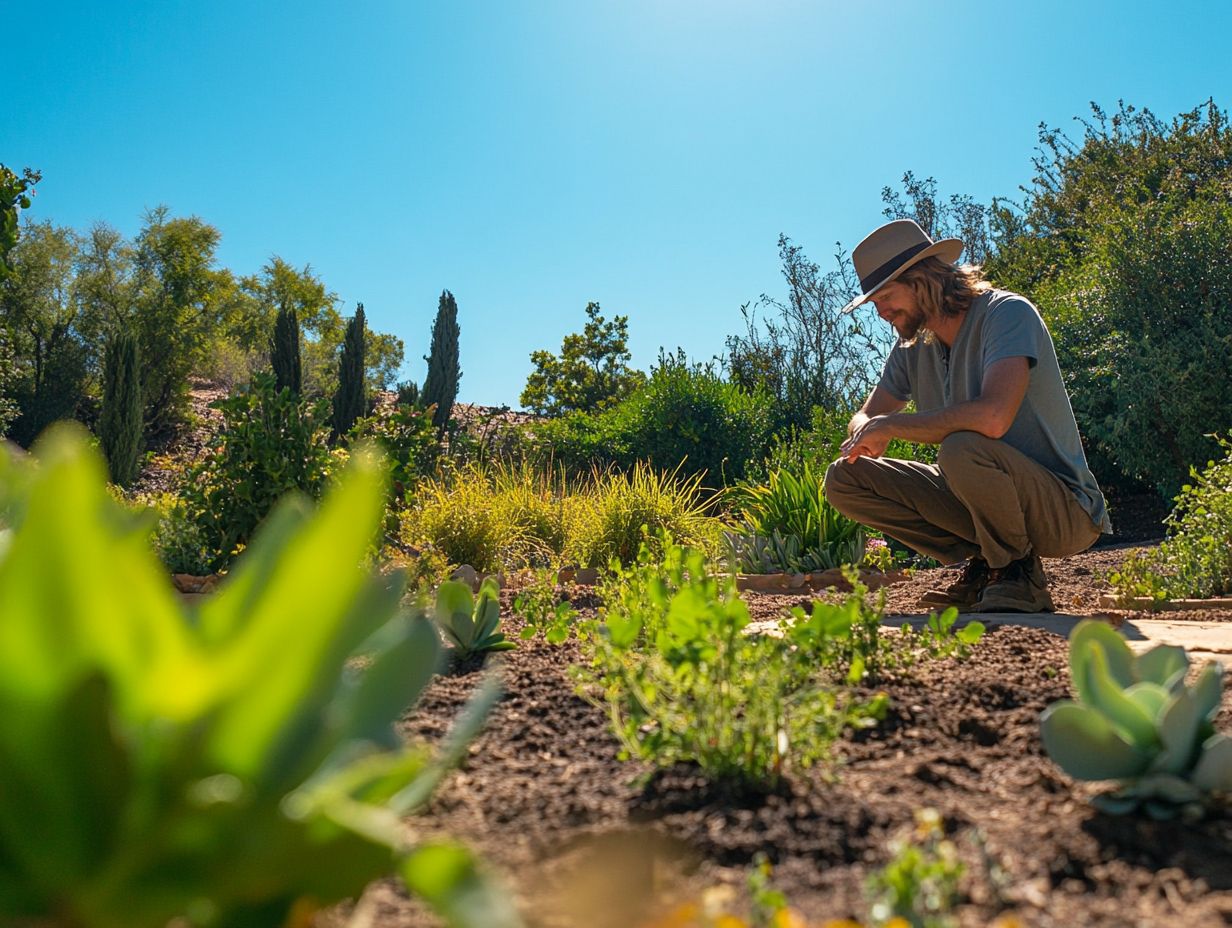
The benefits of drought gardening are truly remarkable. They encourage both resource conservation and sustainable agricultural practices.
By adopting techniques that focus on native and drought-resistant plants, you can cut down on water consumption. This is especially vital in areas facing water scarcity.
This approach conserves essential resources and enhances soil health through the use of organic materials and mulching practices. This bolsters the resilience of the entire ecosystem.
The reduced maintenance costs associated with drought gardening like lower irrigation needs, fewer fertilizers, and minimal pesticides translate into significant economic savings for you and your community.
By engaging in these eco-friendly gardening practices, you not only support local wildlife but also promote a more sustainable method of food production.
Preparing for Drought Gardening
Get excited about drought gardening! Thoughtful planning will set you up for success. Begin by assessing your soil quality; it s the foundation of your garden’s success.
Selecting native plants and vegetables that are well-suited to your region is essential. Don t forget to incorporate compost to boost moisture retention in the soil.
Understanding your local climate is crucial. This knowledge will guide your choices regarding watering systems and protective measures against harsh weather.
Join local gardening communities for valuable tips and resources. This ensures that your drought garden flourishes even in challenging conditions.
Essential Tools and Techniques
Essential tools and techniques for drought gardening include efficient irrigation systems, such as drip irrigation, compost for enhancing soil health, and mulch for moisture retention.
Drip irrigation is a system that delivers water directly to the roots of your plants. This significantly reduces water wastage while encouraging deeper root growth.
Incorporating compost improves soil structure and boosts its ability to retain moisture, which is crucial for supporting plant health during dry spells.
Mulch plays a key role; it prevents evaporation and minimizes weed competition, further enhancing moisture conservation. Together, these elements create a sustainable approach to gardening, empowering your plants to thrive even in tough conditions.
Choosing Drought-Resistant Plants
Choosing drought-resistant plants is a crucial step in your gardening journey. These plants are uniquely adapted to thrive in arid conditions while meeting both the aesthetic and functional desires of your garden.
As you select your plants, consider both native varieties and those that show resilience to low moisture levels like oregano, thimbleberry, and elderberry.
Understanding the characteristics of these plants will help you cultivate a diverse ecosystem that flourishes under challenging conditions. This also attracts beneficial wildlife, enhancing the overall health of your environment.
Act now to select drought-resistant plants for a thriving garden!
Start your drought garden today and contribute to sustainable gardening!
Types of Plants and Their Characteristics

Drought-resistant plants come in various types, such as native plants, succulents, and certain vegetables. Each type has unique attributes that thrive in low-water environments.
Native plants, like the resilient lavender and captivating yarrow, are perfectly adapted to their local climates. They often require no irrigation once established.
Succulents, including agave and aloe vera, have evolved to store water in their fleshy leaves. This makes them ideal choices for xeriscaping, a landscaping method designed to reduce or eliminate the need for irrigation.
You ll also find certain vegetables, like kale and beans, exhibit impressive drought tolerance. This allows you to cultivate crops with minimal water input.
These plants not only help conserve water but also enhance soil health and provide essential habitats for local wildlife.
For optimal growth, aim for well-drained soil, plenty of sunlight, and strategic mulching to retain any available moisture.
Watering Strategies for Drought Gardening
Implementing effective watering strategies for drought gardening is essential. This ensures that your plants receive the necessary moisture while minimizing water waste, particularly during arid seasons.
Techniques like deep watering, utilizing rain barrels, and employing drip irrigation systems can greatly enhance water efficiency. They also promote robust root development in established plants.
By understanding the specific moisture needs of your selected vegetation, you can adjust your watering practices accordingly. This helps cultivate healthier plants that flourish even in challenging conditions.
Efficient Watering Techniques
Efficient watering techniques are essential for mastering drought gardening. They allow you to maximize moisture while conserving precious water resources.
In this context, timing is everything. Early morning or late afternoon is the perfect window for watering, as evaporation rates are significantly lower during these hours.
Drip irrigation systems or soaker hoses help ensure that water penetrates deeply into the soil, fostering robust root development.
Mulching around your plants can drastically minimize moisture loss by shielding the soil from direct sunlight and retaining valuable humidity. Using rain barrels is a fantastic way to capture and store rainwater for those drier spells.
By embracing these techniques, you can cultivate a flourishing garden that is not only resilient but also sustainable.
Maintaining a Drought Garden
Maintaining a drought garden demands continuous care and attention. This focus is crucial for its long-term success.
Embrace techniques that promote soil health, enhance plant resilience, and optimize resource use.
Regular practices like mulching, applying compost, and monitoring soil moisture levels are essential for nurturing your established vegetation.
Be proactive in pest control while steering clear of chemical herbicides to significantly benefit your garden.
Engaging with local gardening resources will equip you with valuable insights and best practices. These are tailored specifically to your unique environment, ensuring sustainable maintenance for your garden’s thriving future.
Tips for Long-Term Success
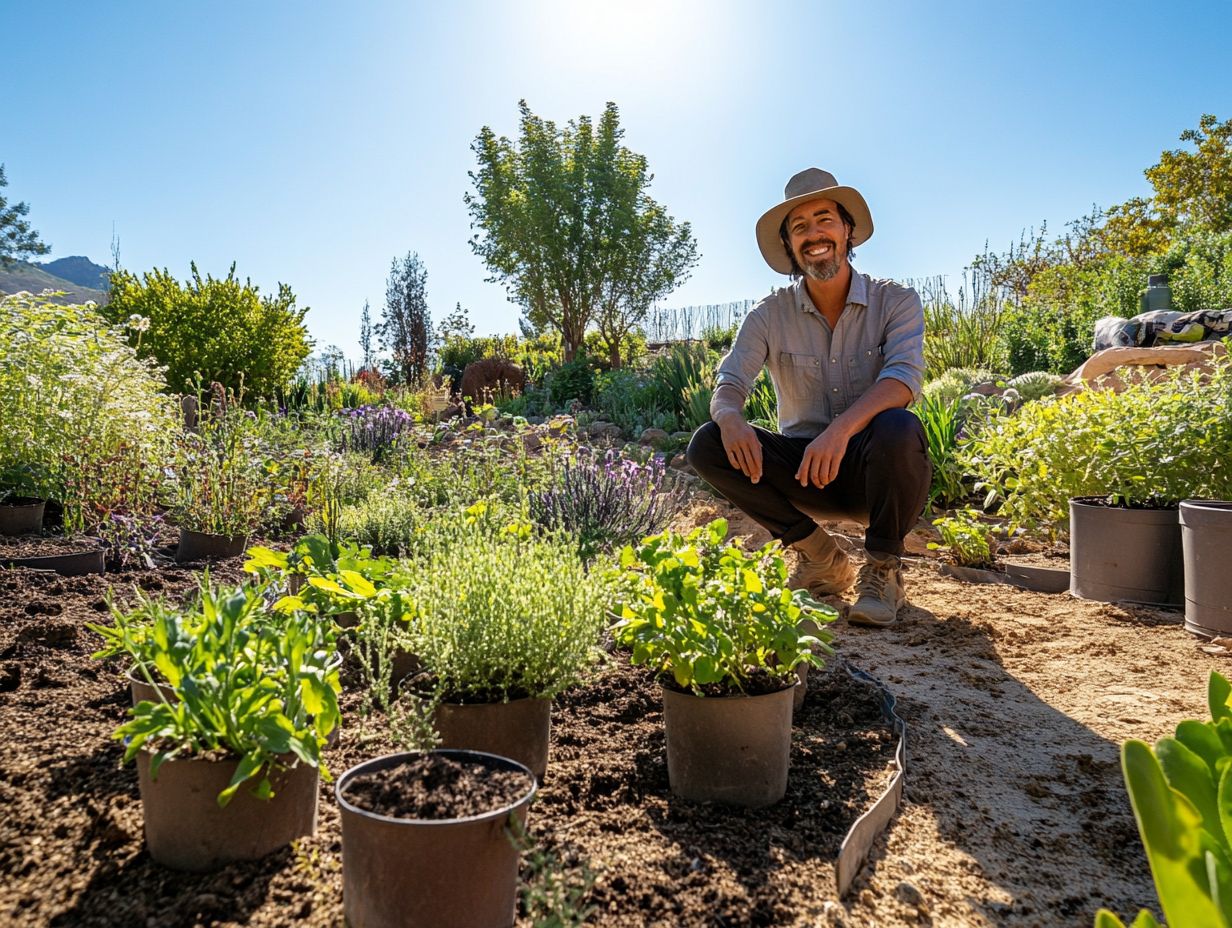
For long-term success in drought gardening, embrace sustainable practices. This includes regular soil testing, strategic plant selection, and efficient water management.
By gaining insight into the specific water needs of various plants, you can cultivate a resilient landscape that thrives even in arid conditions.
Consider incorporating mulch layers to retain moisture and minimize evaporation. Opting for native or drought-tolerant species reduces water usage and nurtures local ecosystems.
Regularly monitoring soil moisture levels ensures that you only irrigate when necessary. This enhances both water efficiency and plant health.
By taking these proactive steps, you ll create a vibrant and sustainable drought garden that truly withstands the test of time.
Frequently Asked Questions
Stay tuned for answers to common questions about drought gardening!
Are you ready to start your drought gardening journey today? Let s get growing!
What are the top questions about drought gardening?
1. What is drought gardening and why is it important?
Drought gardening means choosing plants that can thrive in dry conditions. This practice is crucial as it saves water and helps your garden survive droughts.
2. What types of plants are best for drought gardening?
Look for native plants, succulents, and plants that can survive on little water. These options are ideal for drought gardening.
3. How do I prepare my garden for a drought?
Add mulch and use drip irrigation to help your garden during dry spells. Regularly check the soil moisture to keep your plants healthy.
What are some tips for watering during a drought?
1. How often should I water my garden during a drought?
Water deeply but less often once or twice a week is ideal. This encourages your plants to develop strong roots.
2. Can I use greywater for my drought garden?
Yes, greywater is a great resource for watering! Just avoid sources with harmful chemicals to protect your plants.
3. How can I conserve water in my drought garden?
Conserve water by using mulch and grouping plants with similar watering needs. Efficient methods like drip systems or soaker hoses can also help.

